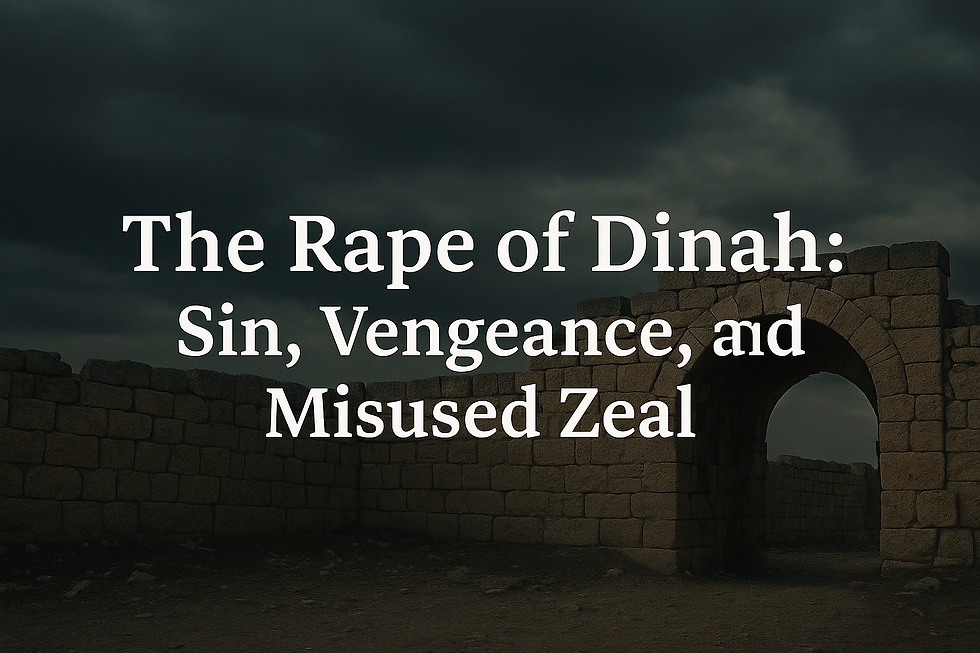Shechem: The Prince Who Violated Dinah
- Bible Believing Christian

- Sep 5
- 3 min read

Shechem: The Prince Who Violated Dinah
Shechem, son of Hamor the Hivite, was a local prince of the city that bore his name. He is remembered in Scripture for his role in one of Genesis’s most troubling events: the violation of Dinah, the daughter of Jacob and Leah (Genesis 34). Though he sought to marry Dinah afterward, his actions set off a chain of violence that left his entire city destroyed by Simeon and Levi. Shechem’s story reveals the destructive power of sin, the dangers of covenant compromise, and the zeal of Jacob’s sons for their sister’s honor.
Name & Etymology
The name Shechem (שְׁכֶם, Šeḵem, pronounced shek-em) means “shoulder” or “ridge,” possibly reflecting the geography of the region. The city of Shechem became one of the most important sites in Israel’s history, associated with Abraham, Joshua, and later covenant renewal. In the Septuagint, his name is rendered Sychem (Συχέμ).
Biblical Narrative (The Story)
The story of Shechem begins when Dinah, daughter of Jacob and Leah, went out to visit the women of the land. “But when the local prince, Shechem son of Hamor the Hivite, saw Dinah, he seized her and raped her” (Genesis 34:2, NLT).
After this, Shechem claimed to love Dinah and wanted to marry her. He spoke tenderly to her and asked his father Hamor to arrange the marriage. Hamor approached Jacob and his sons, urging an alliance between their peoples. “Intermarry with us; give us your daughters, and take our daughters for yourselves” (Genesis 34:9, NLT).
Jacob’s sons, however, responded with deceit. They agreed to the marriage only if every male in Shechem’s city would be circumcised. Hamor and Shechem persuaded their townsmen, who complied. But on the third day, while the men were in pain, Simeon and Levi attacked the city, killing all the males, including Hamor and Shechem, and rescuing Dinah (Genesis 34:25–29).
Jacob rebuked his sons for bringing danger on the family, but they replied: “Should he treat our sister like a prostitute?” (Genesis 34:31, NLT).
Historical & Cultural Context
In the ancient Near East, rulers like Shechem often used marriage alliances to secure political ties. His request to marry Dinah was not unusual, but it came after an act of violence that could not be erased by diplomacy.
The city of Shechem itself would later play a major role in Israel’s history. Abraham built an altar there (Genesis 12:6–7), Joshua renewed the covenant there (Joshua 24), and it later became a center of worship and division in Israel’s story.
Character & Themes
Shechem’s character is deeply flawed. Though he professed love for Dinah, his actions betrayed selfishness and abuse of power. His violation of her was not undone by his later offer of marriage.
Themes from his life include:
Abuse of power: using position and strength for personal gratification.
Covenant compromise: the temptation to unite God’s people with the nations.
False reconciliation: attempts to heal sin through alliances rather than true repentance.
Connection to Christ
Shechem stands in stark contrast to Christ. Where Shechem violated and took, Christ honors and gives. Where Shechem sought union through force, Christ brings union through sacrificial love.
The destruction of Shechem’s city highlights the seriousness of sin, while Christ points to the true justice and mercy of God that heals rather than destroys.
Theological Significance
Shechem’s story emphasizes the dangers of intermarriage with the nations, which could compromise Israel’s covenant identity. It also shows how zeal for justice, as displayed by Simeon and Levi, can be twisted into violent vengeance.
Theologically, Shechem represents the brokenness of human power structures and the need for a just Redeemer.
Myths & Misconceptions
One misconception is that Shechem’s “love” for Dinah made his actions excusable. In truth, love cannot erase or justify sin.
Another misconception is that the alliance proposed by Hamor and Shechem was a good political opportunity. In reality, it threatened to assimilate Jacob’s family into Canaanite culture, endangering the covenant line.
Some also assume Shechem’s fate was unjust. Yet Scripture makes clear that his violation of Dinah was the root cause of the tragedy.
Application
Shechem’s life warns us of the consequences of sin and misuse of power. It challenges us to honor the dignity of others and to seek reconciliation through repentance, not compromise.
It also reminds God’s people to resist assimilation into the world in ways that threaten faithfulness to God’s covenant.
Conclusion
Shechem, the prince who violated Dinah, is remembered as a tragic figure whose sin led to the destruction of his city. His story highlights the dangers of abuse, compromise, and false reconciliation. By contrast, Christ brings true justice and healing. Shechem’s life serves as a warning to honor others and to trust in God’s ways rather than human schemes.


